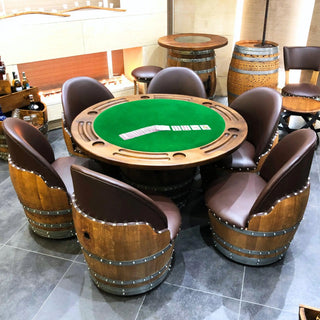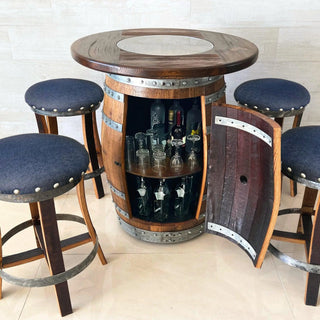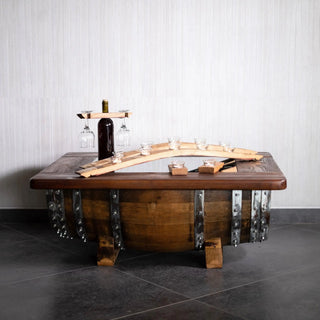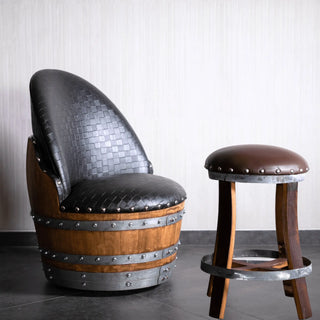How Does Oak Aging Change the Flavor of Wine?
Let me tell you a quick story.
A few years ago, I was standing in a winery’s barrel room. You know the kind — rows of barrels stacked to the ceiling, the air smelling like toast, vanilla, and just a hint of something sweet and mysterious. The winemaker handed me two glasses of wine. Both came from the same vineyard, the same grapes, even the same harvest.
One was aged in a stainless steel tank. It was crisp, fruity, almost like biting into a fresh apple. The other? Aged in oak barrels. I took a sip, and it was like the wine suddenly had a deeper voice. Creamy, rich, with whispers of vanilla and a little smoky spice. Same grape. Two completely different experiences.
That’s the magic of oak. It doesn’t just hold wine — it changes it. Oak turns simple grape juice into something layered, textured, and worth savoring.
But how does it do it? And why does oak matter so much more than, say, steel or glass? Let’s uncork this mystery together.
Oak as the Winemaker’s Spice Rack
Think of oak barrels like a giant spice rack that wine gets to sit inside. While the wine rests, it soaks up subtle flavors and aromas from the wood.
Here’s what oak adds to wine:
- Vanilla and caramel — thanks to natural vanillin in the wood. Ever notice that cozy, dessert-like note in a chardonnay or cabernet? That’s oak.
- Spice — clove, nutmeg, cinnamon, sometimes even black pepper. Oak brings the warmth of a spice cabinet to the glass.
- Smoke and toast — from barrels that have been charred or toasted inside. It’s like adding a faint campfire aroma.
- Coconut and dill — especially from American oak, which is bolder and sweeter than French oak.
- Nutty, toasty flavors — like roasted almonds or hazelnuts, which come out with medium to heavy toasts.
The grape still shines, don’t get me wrong. Oak doesn’t erase the fruit. But it’s like adding butter and garlic to plain bread. The bread’s still there — it just got a whole lot tastier.
Texture: Oak Doesn’t Just Change Taste — It Changes Feel
One of the most underrated things about oak is the way it changes texture.
Wine aged in stainless steel often feels sharp and crisp. That’s great for zesty whites like sauvignon blanc. But when you want something rounder, smoother, more “sit by the fire with a blanket” than “sip by the pool with sunglasses,” oak makes the difference.
Oak barrels allow a tiny bit of oxygen to sneak in — what winemakers call micro-oxygenation. It’s a slow breathing process that softens the wine, taming harsh tannins and making each sip feel velvety instead of jagged.
It’s like comparing a green banana to a perfectly ripe one. Same fruit. Totally different mouthfeel.
Toasting and Charring: Winemaking’s Secret Seasoning
Here’s something most people don’t know: before barrels are filled, their insides are toasted or even charred. Picture a cooper (barrel-maker) with an open flame, carefully toasting the inside like a marshmallow.
- Light toast: Subtle vanilla and delicate spice.
- Medium toast: Caramel, nuts, gentle toastiness.
- Heavy toast/char: Espresso, smoke, deep caramelization.
It’s like roasting coffee beans — the longer the roast, the deeper the flavors. The winemaker chooses the level of toast like a chef chooses seasoning.
So when you taste that smoky edge in your cabernet or that rich caramel note in your chardonnay, thank the fire-kissed inside of the barrel.
Different Oaks, Different Accents
Not all oak is the same. Depending on where the tree grew, the flavors it gives the wine are totally different.
- French oak: Elegant, subtle, spicy. Think whispers, not shouts. Perfect for pinot noir and Burgundian chardonnay.
- American oak: Sweet, bold, louder. Vanilla, coconut, sometimes dill. Perfect for cabernet, syrah, or Rioja wines.
- Hungarian/Eastern European oak: Middle ground — spice and structure without being too aggressive.
If French oak is like a smooth jazz saxophone, American oak is a rock guitar solo. Both amazing, just different vibes.
Red Wines and Oak: A Perfect Match
Some grapes practically beg for oak.
- Cabernet Sauvignon & Merlot: Naturally bold, tannic, and sometimes a little grumpy. Oak smooths them out while layering in spice and vanilla. That’s why Bordeaux and Napa cabernets taste so luxurious.
- Pinot Noir: This grape is delicate, so it needs a gentle touch. Too much oak smothers it. But just the right French oak? It becomes pure elegance — silk in a glass.
- Syrah/Shiraz: Loves oak. It’s where those peppery, smoky, savory flavors come from. Barossa Valley shiraz practically sings with oak aging.
- Tempranillo (Spain): Rioja’s whole identity is built on oak aging. From 12 months in Crianzas to 2+ years in Gran Reservas, the result is spice, leather, and dried fruit layered beautifully.
Without oak, these wines would still be drinkable. With oak? They become unforgettable.
White Wines: Oak’s Gentle Makeover
Oak doesn’t only play well with reds. Some whites get transformed by it.
- Chardonnay: The poster child of oak. Stainless-steel chardonnay tastes like tart green apples. Oak-aged chardonnay? Buttery, creamy, with vanilla and toast. That’s why it’s so polarizing — people either love it or hate it.
- Sauvignon Blanc: Normally sharp and zesty, but oak-aged versions (fumé blanc) gain smokiness and roundness. It’s like sauvignon blanc in a cozy sweater.
- Viognier: This already-perfumed grape becomes richer and fuller with oak, while still keeping its apricot and floral notes.
Oak can turn a crisp summer white into something that feels tailor-made for winter comfort food.
Sweet & Dessert Wines: Oak’s Secret Weapon
Oak aging isn’t just for table wines. Dessert and fortified wines benefit too.
- Ice wine: Usually kept in stainless steel for freshness. But oak-aged versions pick up spice and caramel that balance the sugar beautifully.
- Port & Sherry: Live in barrels for decades, soaking up nutty, oxidative flavors that make them taste like liquid dessert.
- Madeira: Sometimes aged for 30+ years in oak, creating roasted nut and toffee notes. These wines are basically liquid antiques.
Oak doesn’t just sweeten the deal — it gives dessert wines complexity, preventing them from being cloying.
How Long Is Long Enough?
Time is the other big factor. Too short, and oak barely makes a difference. Too long, and the wine tastes like a lumber yard.
- Light whites: 3–6 months. Just enough for creaminess.
- Chardonnay: 6–12 months. The buttery sweet spot.
- Bold reds: 12–24 months. Sometimes more, depending on style.
- Dessert & fortified wines: Years, even decades.
Winemakers taste constantly, deciding the exact moment when oak and grape are perfectly balanced. It’s less science, more art.
Life After Wine: Barrels Don’t Retire
Here’s my favorite part: barrels don’t stop telling stories once the wine leaves.
- Whiskey distillers grab them. Ex-wine barrels give whiskey and bourbon a fruity edge.
- Brewers experiment. Ever had a barrel-aged stout or sour beer? Thank old wine barrels.
- Furniture makers (like Oak Wood Wine Barrels). Retired barrels get reborn as rustic furniture. Instead of collecting dust in a cellar, they anchor living rooms and patios.
That’s full-circle magic.
Wine Barrel Furniture: History You Can Touch
At Oak Wood Wine Barrels, we see this every day: barrels moving from winery workhorses to heirloom furniture.
- A Wine Barrel Coffee Table with Removable Glass Top isn’t just a table — it’s a conversation starter.
- A Wine Barrel Dining Set with Removable Top hosts family dinners, poker nights, and everything in between.
- A Wine Rack Wall Mount Trio Glass Display turns an empty wall into a rustic mini cellar.
- A Wine Barrel Fire Pit makes summer nights unforgettable.
Every scratch, every iron hoop, every charred mark whispers its past life. That’s what makes barrel furniture more than décor. It’s living history.
Our Links
- Discover rustic wine barrel dining sets.
- Relax with handcrafted oak barrel chairs & seating.
- Add warmth with unique barrel coffee tables & chests.
Other Resources to Check Out!
Final Thoughts
So, how does oak aging change the flavor of wine? In every way that matters. It adds spice, vanilla, smoke, and toast. It softens sharp edges. It turns fresh grape juice into layered, complex wine that makes you want to sip slowly and think about life a little.
And when the wine moves on, the barrel doesn’t stop shaping stories. It becomes furniture, fire pits, décor. It moves from winery cellars into our homes, carrying whispers of every drop it once held.
That’s why oak matters. It doesn’t just change wine. It changes the way we experience it — and, in a way, it changes us.
Disclaimer:
This blog is for informational and entertainment purposes only. It reflects general knowledge and personal observations about oak aging and wine flavor. Aging outcomes vary depending on grape variety, winemaking style, barrel type, and time. Oak Wood Wine Barrels cannot guarantee accuracy of every detail or outcomes of DIY projects. Always consult trusted winemakers or resources for specifics. For official product specifications, availability, and care instructions, please visit our site. Nothing here is professional, financial, or legal advice — just a celebration of barrels, their history, and the creativity they inspire.




